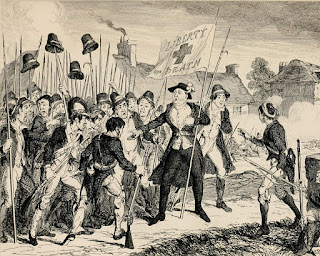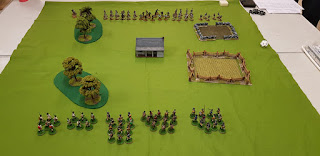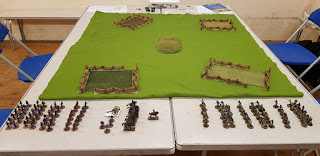 |
| Battle of Vinegar Hall |
My 1798 Irish Rebellion project may not reach the table before next year, but I’ve been doing some research on Irish pikemen which has led me to think again about how they should be classified for
Rebels and Patriots.
The Irish pikes of 1798 were typically 8-12 feet including the head, and while sometimes referred to as "half-pikes" because they were shorter than the lengths that had been used during the Civil War and earlier, they were nevertheless pikes and used in the same way. (My model pikes will be 60mm, i.e. about double the height of the foot figures.)
Rampant rules typically have an infantry type equivalent to
Lion Rampant's Fierce Foot. In
Dragon Rampant it's Bellicose Foot and in
The Pikeman's Lament it's Clansmen. In
RAP there are Natives, but these are more like skirmishers.
This suggested that I might have to invent a new unit type to accommodate charging pikemen, but putting aside the question of firearms for the moment, contemporary sources (see below) have convinced me that the closest unit definition is in fact Line Infantry.
While it might be assumed that Irish pikemen were a wild mob of uncoordinated warriors fighting as individuals, and while they may have been poorly trained and disciplined, they were drilled to manoeuvre and fight as close order infantry and could and did see off cavalry.
The Irish leader Joseph Holt left memoirs in which he wrote: "My pikemen were the most difficult to manage. I had to teach them to step in time, to face about, countermarch, wheel about, but particularly to disperse and form rapidly, and to march in quick or double quick time."
 |
Contemporary illustrations depict Rebels
with mixed weapons. |
Now to the question of firearms. They were scarce but preferred to pikes if they could be obtained. Civilian blunderbusses were supplemented with stolen civilian pieces and captured muskets.
It makes good military sense to organise differently-armed soldiers into separate units, and there were separately organised firearm skirmishers such as the famous Shelmaliers with their long-barreled fowling guns and sharpshooter reputation.
However, it also seems likely that Rebel bands would randomly accumulate a proportion of firearms without being reorganised on a rational basis, and this is how they are depicted in contemporary illustrations.
The memoirs of the Irish Rebel, Myles Byrne, specifically refer to small mixed units. Byrne says that they had nothing to fear from the Yeomen, "for twenty pikemen that kept together, with two or three with fire-arms, was quite sufficient to keep the best of those corps at a respectful distance."
All in all, the references to close order drill and the concept of pike units with mixed weaponry would, I believe, justify the definition of Irish pikemen as:
Line Infantry, Aggressive, Poor Shooters, Green @ 3.
This keeps them within the standard rules and distinguishes them from their Militia opponents who I would define as:
Line Infantry, Green @ 3.
If you wanted to discount firing altogether, then you could define a new unit type with no firing and, maybe, a cost of 2, but I personally prefer to avoid house rules if at all possible.
REFERENCES
The Irish Pike
G. A. Hayes-McCoy
Journal of the Galway Archaeological and Historical Society
Vol. 20, No. 3/4 (1943), pp. 99-128
https://www.jstor.org/stable/25535242
Methods of Using the Pike in Ireland: 1798-1921
https://outofthiscentury.wordpress.com/2017/10/19/methods-of-using-the-pike-in-ireland-1798-1921/


























